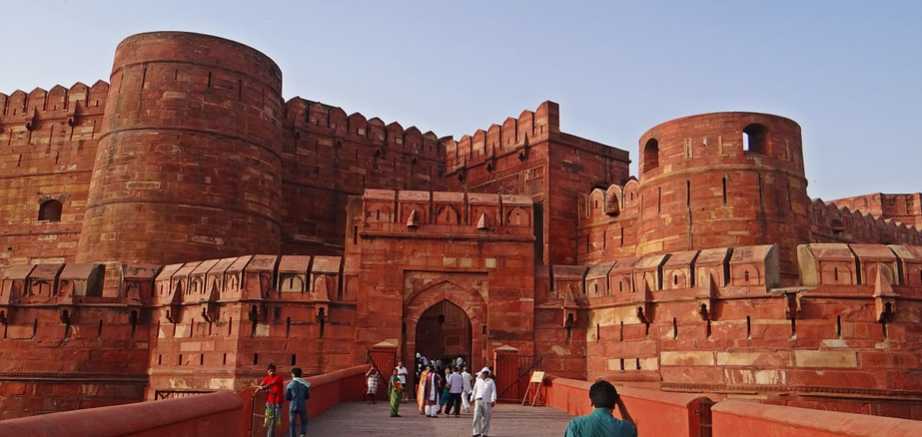
History of Agra Fort
Sikandar Lodi was the first Sultan of Delhi who shifted his capital from Delhi to Agra. His son Ibrahim Lodi held the fort which was then known as Badalgarh for nine years until he was defeated in the first battle of Panipat. When Babur sent his son Humayun to Agra, he captured the Badalgarh Fort and seized a vast treasure which included the famous Kohinoor diamond. Humayun was coroneted here in 1530. After Humayun's defeat to Sher Shah Suri, the Mughals lost the fort again. When Akbar arrived in Agra in the year 1558, he realized the importance of the city and made it its capital. Akbar regained the remains of the Badalgarh Fort and renovated it with red sandstone from Rajasthan. 4000 builders worked on it and it was finally completed in 1573, after a period of 8 years. Shah Jahan, who was Akbar's grandson destroyed some of the buildings in the fort to make his own in their place, rendering the Agra Fort as it is today. Towards the end of Shah Jahan's life, his son Aurangzeb detained him in the fort's Muasamman Burj, which overlooked the Taj Mahal.
The early 18th century saw the Marathas invading the Agra Fort, and the ownership of the fort changed successively many times. After their defeat in the Third Battle of Panipat at the hands of Ahmad Shah Abdali in 1761, they were decisively driven out of the region for the next ten years. Mahadji Shinde overtook the Agra Fort in the year 1785, and the Marathas held its reigns until the 1803 Second Anglo - Maratha War when they lost it to the British. The fort was the site of a battle during the Indian rebellion of 1857, which brought along a century of direct rule of British Rule in India.
Structure of Agra fort
The Red Fort in Agra spreads across an area with radius three kilometres and is bordered by a 70 feet tall wall. The walls are made of red sandstone and they completely surround the fort from all the directions. Agra Fort has a semi circular plan and double ramparts have been provided in the fort with broad circular bastions at regular intervals. The fort has four main gates on its four sides. One of these gates was known as the Khizri gate and it opens to the river front. At present, there are over two dozen monuments in the fort. Abul Fazl, historian of Akbar records that 5000 buildings were built here in Bengali as well as Gujarati style but those buildings have disappeared now.
Famous buildings inside the Fort
The historic and cultural importance of the Agra Fort is enhanced by the fact that it houses a number of important structures within its bounds. Some of them are:-
1. Jehangir Mahal: One of the first architectures that you will encounter once you enter the Agra Fort through the Amar Singh Gate is the Jehangir Mahal. Jehangir was Akbar's son and the next in line to rule the Mughal empire after his father. The Jehangir Mahal was built by Akbar as a women's quarters and was constructed adjacent to the chambers of his favourite queen Jodha Bai. Simple in its design, the Jehangir Mahal is built in stone and has Persian verses carved out beautifully in a large stone bowl used for storing rose water.
2. Khas Mahal: Another important structure in the Agra Fort is the Khas Mahal, which has some classical Persian and Islamic influences with a touch of Hindu motifs in its construction. It was the emperor's sleeping chambers or 'Araamgah'. Its unique feature is its beautiful paintings on the marble surface.
3. Musamman Burj: Towards the left of the Khas Mahal lies the Musamman Burj, which was also built by Shah Jahan. Octagonal in shape, this tower has an open pavilion which allowed the cool evening breeze to flow right through it. This was the place where Shah Jahan spent his last days whilst he looked out over to to the tomb of his beloved wife, the Taj Mahal.
4. Sheesh Mahal: One of the most exquisite constructions in the Agra Fort, the Sheesh Mahal is a 'harem' or dressing room that employs the most sophisticated water engineering designs. The inside of this construction is beautifully decorated with a mosaic of myriad tiny mirrors, hence giving it its name.
5. Diwan - I- Khaas: To the right of the Sheesh Mahal lies the Diwan - I - Khaas, which was a hall especially for private audiences. It is intricately decorated with marble pillars that are studded with floral patterns of semi - precious stones. Adjacent to this is the Mammam-E-Shahi or the Shah Burj, used as the summer retreat.
6. Diwan - E - Am: This was the hall that was open to the general public. It was here that the very famous Peacock Throne was situated, and the room where the throne once used to be is richly decorated with white marble.
7. Nagina Masjid: This shrine was built by emperor Shah Jahan as a private mosque for the ladies of the court.
8. Moti Masjid: Also known as the Pearl Mosque, it is an extremely beautiful structure situated at Agra Fort. The building of the mosque is closed to visitors as of now. Near the Moti Masjid lies the Mina Masjid, which was the private shrine of Emperor Shah Jahan.
Best time to visit Agra Fort
The best season to visit this destination is from November to February. Best time during the day is morning and evening hours.
How to Reach Agra Fort
You can reach the Agra Fort from any point in the city through any of the local transportation like bus, autorickshaw or taxi. Also, tongas and electric autos are readily available in Agra.
Top Tourist Places in Agra
Agra Fort
Fatehpur Sikri
Itimad-ud-daula's Tomb
City Shopping
Akbar's Tomb
Jama Masjid
All Tourist Places in Agra
Shopping in Agra Fort
Located very close to the Fort is the Sadar Bazaar, and is one of the most popular shopping destination among tourists. You can buy a wide variety of articles here, from leader goods to delicious sweet 'pethas'.
Tips
1. Carry your identity cards when you visit this destination2. Food items, liquor, tobacco, head phones, knives, wire, mobile charger, electronic goods (except camera) are prohibited 3. Mobiles must be kept switched off4. Vandalism of the site is strictly prohibited5. Visitor must keep noise to a minimum
Photos of Agra Fort
Comments on Agra Fort
Post Your Comment






















